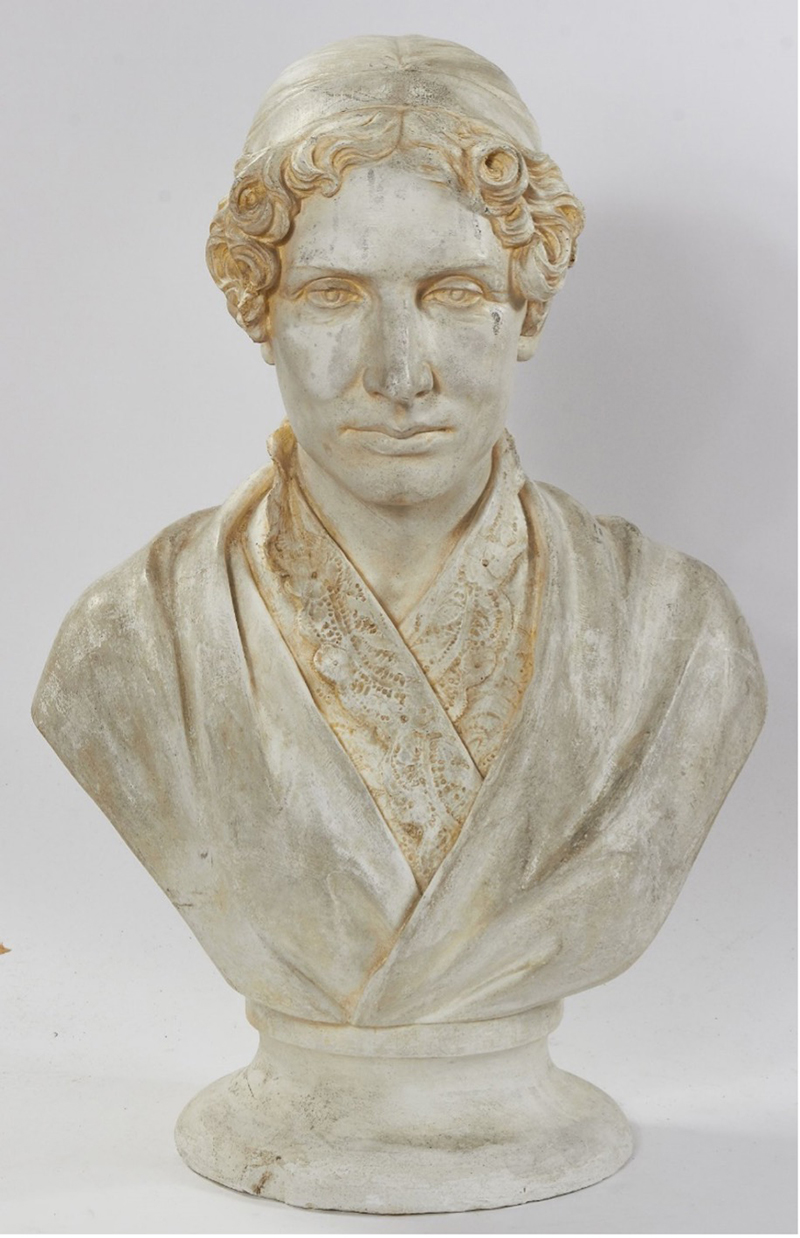Object of the Month: Harriet Beecher Stowe by Anne Whitney
By Bowdoin College Museum of Art
Harriet Beecher Stowe, 1893, plaster by Anne Whitney, American, 1821–1915
Last fall, the BCMA welcomed into the collection a striking plaster bust of author and abolitionist Harriet Beecher Stowe (1811–1896) by the Boston-based sculptor Anne Whitney (1821–1915). The bust is remarkable for the way that Whitney endowed the sitter—at the time in her early eighties and in declining health—with a dignified, almost ageless appearance, save for the few creases around the eyes to suggest wrinkles. Stowe’s sharply rendered features and slightly downcast gaze underscore both her humanity and gravitas. This plaster formed the model for a marble bust, both completed in 1893, and was actually the second version of a bust-length portrait of Stowe created by Whitney. Evidently under the direction of Stowe’s half-sister, Isabella Beecher Hooker (1822–1907), a “committee of ladies” commissioned Whitney in February 1893 to make a portrait of Stowe, first to be exhibited at the World Columbian Exposition and later destined for the Public Library in Hartford, Connecticut. Hooker admired the bust so much that she commissioned Whitney to create a second version. The two marble busts and first plaster model are all currently housed at the Harriet Beecher Stowe Center in Hartford.
The bust recently acquired by the BCMA represents far more than just a plaster model for a marble portrait. The commission for and creation of this work (and the one that preceded it) brought together three women who were, through diverse means, powerful advocates for the abolition of slavery and, following the United States Civil War (1861–1865), equality for women. During the nineteenth century, Stowe was a renowned author both in the United States and abroad. That Uncle Tom’s Cabin was being celebrated in the context of a universal exhibition forty years after its original publication testifies to Stowe’s national and international importance in her own time. Stowe’s sister, Isabella Beecher Hooker, was likewise an abolitionist, though best known for her decades-long campaigning, lecturing, protesting, and appearing before Congress for women’s right to vote. Anne Whitney’s sculptures often espoused her sympathy toward social and political inequities, whether they involved newly emancipated African Americans, the working classes of Rome, or politically disenfranchised women.
Stowe, of course, had strong ties to Brunswick and the Bowdoin campus. It was here that she wrote Uncle Tom’s Cabin after allegedly receiving a vision in the First Parish Church on Maine Street. Despite the author’s importance to the town and College’s histories, the BCMA collection currently holds only one likeness of Stowe—a small studio photograph that figures her alongside her brother Henry Ward Beecher (1813–1887). The acquisition of this bust, along with a pair of relief carvings by Italian sculptor Lot Torelli (1835–1896), depicting scenes from Uncle Tom’s Cabin begins to fill in this unexpected lacuna. The fact that Whitney’s other three exemplars are housed at the nearby Stowe Center in Hartford ensures that her depictions of Stowe are stewarded by institutions that have deep historical connections to the author.
While Stowe herself continues to be celebrated by many as an important figure in the abolition of slavery, the depiction of enslaved Black characters in Uncle Tom’s Cabin and the work’s sentimentalism have been rightfully critiqued, famously by author James Baldwin among others. The sculpture also opens up complex and nuanced conversations about gender and representation in nineteenth-century American art, particularly sculpture. On the one hand, Whitney’s example impels critical examination of the status of women artists in the canon, as she created numerous well-known public sculptures; nevertheless, her relationship to some of her most famous works is relatively little known. On the other hand, the bust is a caring and dignified portrait of an elderly and venerated woman depicted by a woman. That Whitney herself carried on a life partnership with a woman (also a prominent advocate for social justice and women’s suffrage) would lend to conversations about historical conceptions of identity and sexuality.
The acquisition was made possible by the research of BCMA co-director Frank Goodyear and Andrew W. Mellon postdoctoral curatorial fellow Sean Kramer, including a visit to the Smith College Museum of Art (SCMA) in Northampton, Massachusetts, and the Stowe Center. The goals of these visits were to examine the physical state of some of Whitney’s other surviving plaster works and to learn more about the history of the bust and its three companions. Frank and Sean delved into SCMA storage along with their Director Jessica Nicoll. In Hartford, they found themselves crawling on an attic floor to see the backs of marble sculptures that couldn’t be moved and then combed through Isabella Beecher Hooker’s correspondence for more details about the commission. Their findings from this trip were then presented to a committee of faculty and external advisors, who expressed their enthusiastic support of the purchase.
Before arriving on campus, the bust will be residing with a conservator in New York City for some surface treatment. The structural condition of the sculpture is remarkably stable, given its age and the fact that plaster is a relatively fragile medium. We hope to know how much restoration is recommended by the start of the new year. Stay tuned!
Sean Kramer, Andrew W. Mellon Postdoctoral Curatorial FellowBowdoin College Museum of Art